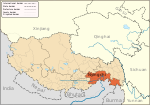Tibet Cheezheng Tibetan Medicine
Tibet Cheezheng Tibetan Medicine (Chinese: 西藏奇正藏药股份有限公司), or Tibet Qizheng Tibetan Medicine Co., Ltd (abbreviated as Qizheng Tibetan Medicine,Chinese: 奇正藏药, SZSE: 002287) is a prominent firm in the Tibetan medicine sector in China,[1] primarily focused on the research, development, manufacture, and sales of Tibetan medicinal products.[2][3]
History
[edit]In 1994, Yangjin Lamu encountered Lei Jufang (Chinese: 雷菊芳) during their collegiate years at Northwest Minzu University, and together they established Qizheng Tibetan Medicine in Nyingchi, Tibet in 1995.[4][5] The company was listed on the Shenzhen Stock Exchange in 2009.[6] The company currently possesses 22 wholly-owned and holding subsidiaries, including GMP pharmaceutical factories and GSP marketing firms, employing 3,091 people. It offers 25 exclusive varieties and holds 141 drug approval numbers, with its products encompassing the musculoskeletal, nervous, digestive, cardio-cerebral, respiratory, urinary, gynecological, dermatological, and pediatric fields, among others.[7][8]
In the 2016 Forbes list of China's 400 Richest, the company's founder Lei Jufang was considered the wealthiest Chinese woman in medicine. She was worth US$1.85 billion ranking No. 146 in the list.[9]
Products
[edit]Qingpeng ointment and Xiaotong paste are produced by the company.[10] The Qingpeng ointment manufactured by the company has active ingredients such as Herba Oxytropis Falcatae (Jidou), Rhei Spiciforme Randix (Yadahuang), Radix Aconiti Flavi Et Penduli (Tiebangchui), Chebulae Fructus (Hezi), Phyllanthi Fructus (Yuganzi), and artificial Moschus (Shexiang).[11]
The company also produce the Guijiu 25 pill (aolse nyer Lang in Tibetan).[10]
References
[edit]- ^ Regional Development Dialogue. United Nations Centre for Regional Development. 2000. p. 200. ISSN 0250-6505. Retrieved 2024-11-21.
- ^ 中国中小企业发展年鉴编委会 (2007). 中国中小企业发展年鉴/2006 (in Chinese). 中国大地出版社. p. 500. ISBN 978-7-80097-946-0. Retrieved 2024-11-21.
- ^ Craig, S.R. (2012). Healing Elements: Efficacy and the Social Ecologies of Tibetan Medicine. University of California Press. p. 175. ISBN 978-0-520-95158-7. Retrieved 2024-11-21.
- ^ 辉煌的二十世纪新中国大纪录: 西藏卷 (in Chinese). 红旗出版社. 1999. p. 1074. ISBN 978-7-5051-0374-0. Retrieved 2024-11-21.
- ^ 中國婦女 (in Chinese). 中国妇女社. 2001. p. 13. Retrieved 2024-11-21.
- ^ 中国民族 (in Chinese). 民族团结杂志社. 2009. p. 187. Retrieved 2024-11-21.
- ^ Saxer, M. (2013). Manufacturing Tibetan Medicine: The Creation of an Industry and the Moral Economy of Tibetanness. Epistemologies of Healing. Berghahn Books. p. 218. ISBN 978-0-85745-775-2. Retrieved 2024-11-21.
- ^ Tibet Information Network (2004). Tibetan Medicine in Contemporary Tibet: Health and Health Care in Tibet II. Tibet Information Network. p. 76. ISBN 978-0-9541961-7-2. Retrieved 2024-11-21.
- ^ Dolan, Kerry A. "China's Richest Healthcare Billionaires Are Prospering Amid Growing Demand For Drugs". Forbes. Retrieved 2024-12-14.
- ^ a b Luo, Hui; Zhong, Gejia; Yue, Lifeng; Wang, Qian; Ma, Lina; Luobu, Zhaxi (2015-10-01). "Traditional Tibetan medicine in China: A systematic overview of randomized clinical trials". European Journal of Integrative Medicine. 7 (5): 450–459. doi:10.1016/j.eujim.2015.05.001. ISSN 1876-3820.
- ^ Shang, Ya-xi; Wei, Shu-feng; Yang, Ke-peng; Liu, Yuan; Wei, Su; Dong, Xia; Wang, Xin-chang; Xie, Zhi-min; Fang, Ru-lu; Liang, Li-na; Li, Xiu-feng; Xu, Lei; Chen, Mu-zhi; Zhang, Kai-xian; Huang, Ji-yong (2024-01-04). "Efficacy of Qingpeng ointment (a Tibetan medicine) for acute gouty arthritis: a multi-center, randomized, double-blind, placebo-controlled trial". BMC Complementary Medicine and Therapies. 24 (1): 21. doi:10.1186/s12906-023-04328-7. ISSN 2662-7671. PMC 10768221. PMID 38178115.

